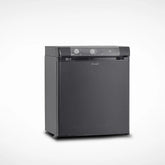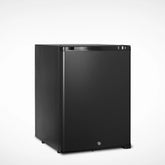Fridge Cooling Systems: Settings, Tips & Trouble shooting
ⅠIntroduction
In our modern lives, refrigerators play an indispensable role in preserving food and beverages, ensuring they remain fresh and safe to consume. The efficiency of a refrigerator directly impacts food quality and storage costs. Understanding how different cooling systems work, how to set the right temperatures, and how to troubleshoot common issues can greatly enhance your refrigerator's performance and longevity. This blog provides a comprehensive guide to refrigerator cooling systems, optimal temperature settings for various foods, and solutions to common cooling problems.
ⅡCooling System Types
Refrigerators primarily use three types of cooling systems: compressor-based, absorption-based, and thermoelectric. Each system operates on different principles and has its own advantages and disadvantages.
1.Compressor Refrigerators
-Explanation of Vapor-Compression Cycle
Compressor refrigerators are the most common type found in households and commercial settings. They operate using the vapor-compression refrigeration cycle, which involves several key components:
①Compressor: This device compresses the refrigerant gas, raising its pressure and temperature.
②Condenser: The hot, high-pressure refrigerant gas flows through the condenser coils, where it releases heat and condenses into a liquid.
③Expansion Valve: The liquid refrigerant passes through an expansion valve, where its pressure and temperature drop.
④Evaporator: The cold, low-pressure liquid refrigerant then flows through the evaporator coils, absorbing heat from the refrigerator interior and evaporating back into a gas.
The continuous cycle of compression, condensation, expansion, and evaporation maintains the desired temperature inside the refrigerator. An example of a compressor refrigerator is the SMAD portable car refrigerator, known for its fast cooling and low noise levels. Its design makes it ideal for travel and outdoor activities.
2.Absorption Refrigerators
-Explanation of Absorption Refrigeration Cycle
Absorption refrigerators, also known as thermoelectric or gas refrigerators, use a heat source such as electricity, gas, or solar energy to drive the cooling process. This system involves:
①Heat Source: Provides the necessary energy to drive the cooling cycle.
②Absorber: Contains a liquid absorbent that absorbs the refrigerant gas.
③Generator: Heats the absorbent-refrigerant mixture, causing the refrigerant to evaporate and separate from the absorbent.
④Condenser: The refrigerant gas flows through the condenser coils, releasing heat and condensing into a liquid.
⑤Evaporator: The liquid refrigerant flows through the evaporator coils, absorbing heat from the refrigerator interior and evaporating back into a gas.
SMAD absorption refrigerators, for example, can operate using various energy sources, making them suitable for different environments.
3.Thermoelectric Refrigerators
Explanation of Peltier Effect
Thermoelectric refrigerators use the Peltier effect, where an electric current creates a temperature differential across a thermoelectric module, causing one side to cool while the other side heats up. This cooling method involves:
①Thermoelectric Module: Utilizes the Peltier effect to create cooling.
②Heat Sink: Dissipates heat from the hot side of the module.
③Fan: Helps distribute heat away from the module to enhance cooling efficiency.
ⅢCooling Mechanism Analysis
Understanding how each cooling system works can help you make informed decisions about your refrigerator and diagnose potential issues.
1.Compressor Refrigerators
-How the Compressor Increases Refrigerant Pressure and Temperature
The compressor raises the refrigerant's pressure and temperature by compressing the gas. This high-pressure gas then releases its heat in the condenser, turning into a liquid. The refrigerant then passes through an expansion valve, dropping in temperature and pressure before absorbing heat in the evaporator and turning back into a gas.
-Heat Dissipation in the Condenser and Cooling in the Evaporator
The heat released in the condenser ensures that the refrigerant cools down before entering the evaporator, where it absorbs heat from inside the refrigerator, maintaining the desired temperature.
2.Absorption Refrigerators
-How Heat Drives Refrigerant Absorption and Release
In an absorption refrigerator, heat from a source like gas or electricity drives the refrigerant’s absorption and release cycles. The absorbent solution absorbs the refrigerant gas, which is then heated to separate the refrigerant, allowing it to condense and evaporate in the respective components.
-Roles of Absorber and Generator in the Cooling Cycle
The absorber captures the refrigerant gas, while the generator heats the solution to release the refrigerant. This cycle ensures the refrigerator maintains a consistent cooling effect.
3.Thermoelectric Refrigerators
-Direct Cooling Effect of Current on Thermoelectric Module
Electric current flows through the thermoelectric module, creating a temperature difference between the two sides. One side cools while the other side heats up, allowing for effective temperature control.
-Heat Dissipation via Heat Sink and Fan
The heat sink and fan work together to remove excess heat from the hot side of the module, enhancing the cooling efficiency of the thermoelectric system.
ⅣOptimal Temperature Settings
Proper temperature settings are crucial for preserving the freshness and safety of stored items. Here’s how to set your refrigerator and freezer for optimal performance:
1.General Guidelines
-Recommended Refrigerator Temperature: 35°F to 38°F (1.7°C to 3.3°C)
-Recommended Freezer Temperature: 0°F (-18°C)
These temperatures ensure that food remains fresh and safe.
2.Ideal Temperature for Specific Items
-Fruits and Vegetables: 32°F to 40°F (0°C to 4°C)
This range helps maintain the freshness of produce while preventing premature spoilage.
-Dairy Products: 34°F to 38°F (1°C to 3°C)
Keeping dairy at these temperatures prevents bacterial growth and spoilage.
-Meats and Seafood: 32°F to 36°F (0°C to 2°C)
This ensures that meat and seafood are kept at a safe temperature to prevent foodborne illnesses.
-Frozen Foods: 0°F (-18°C) or lower
Maintaining this temperature ensures that frozen items stay solid and are preserved for longer periods.
The SMAD refrigerator models can be adjusted to meet these standard temperature ranges and can accommodate specific needs with flexible settings.
ⅤCommon Cooling Issues and Troubleshooting
Refrigerators can encounter various cooling issues. Understanding these problems and how to address them can help maintain optimal performance.
1.Insufficient Cooling
-Check Thermostat Settings
Ensure that the thermostat is set to the correct temperature range for effective cooling.
-Ensure Door Seals are Intact and Not Leaking
Inspect door seals for any cracks or damage that might allow warm air to enter.
-Verify Condenser Coils are Clean and Unobstructed
Dirty or blocked condenser coils can impair cooling efficiency. Regular cleaning is essential.
-Assess Compressor Functionality
A malfunctioning compressor can impact overall cooling performance.
2.Uneven Cooling
-Check for Proper Airflow Inside the Refrigerator
Ensure that air vents are not blocked by stored items, which can lead to uneven cooling.
-Ensure Items are Not Blocking Vents
Proper air circulation is necessary for consistent cooling throughout the refrigerator.
-Verify Evaporator Fan Operation
A malfunctioning fan can result in poor cooling performance.
3.Complete Cooling Failure
-Confirm Power Supply to the Appliance
Ensure that the refrigerator is plugged in and receiving power.
-Check for Tripped Circuit Breakers or Blown Fuses
Inspect the electrical system to ensure there are no issues affecting the refrigerator’s power supply.
-Examine Thermostat and Temperature Controls
Verify that these settings are correct and functioning properly.
-Assess Start Relay and Overload Protector
These components are crucial for the refrigerator’s operation and may need inspection or replacement if faulty.
ⅥConclusion
Understanding refrigerator cooling systems, setting the right temperatures, and troubleshooting common issues are essential for maintaining a reliable and efficient refrigerator. By familiarizing yourself with these aspects, you can ensure optimal performance and extend the life of your appliance. Regular maintenance and proper use will keep your refrigerator running smoothly, providing you with fresh and safe food storage.



